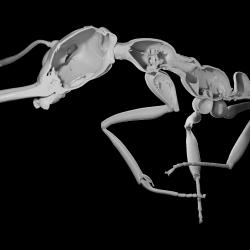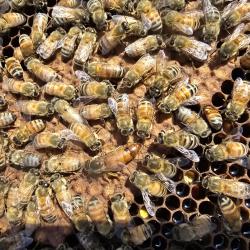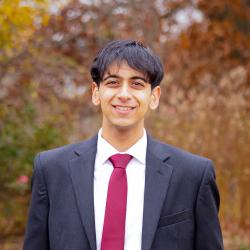Faculty Promotions Announced by UMD College of Computer, Mathematical, and Natural Sciences
The University of Maryland’s College of Computer, Mathematical, and Natural Sciences (CMNS) announced the promotions of 12 tenured/tenure-track faculty members, seven instructional faculty members and 16 research faculty members. Four faculty members were also named Distinguished University Professor—the highest academic honor bestowed by the university.
Tenured/Tenure-Track Faculty Members
Named Distinguished University Professor:
- Bill Fagan, biology, joined UMD in 2002, and he served as chair of the department from 2013 to 2020. He is an ecologist known for his work advancing fundamental theory and often coupling that with creative empirical and informatics research. He is a leader in the field of spatial ecology and has made major contributions to better understand ecological boundaries, fragmentation and animal movement.
- James Farquhar, geology and the Earth System Science Interdisciplinary Center, joined UMD in 2001. He is a scientific leader in sulfur isotope geochemistry, with publications that address geochemical processes on Earth and elsewhere in the solar system, spanning a variety of eras from the modern to the ancient. He is best known for discovering the geochemical signal that traces the long-term history of atmospheric oxygen. More recently, Farquhar and his collaborators found that Earth’s early atmosphere spent about a million years filled with a methane-rich haze. They also developed a new, more accurate system to study the history of large volcanic eruptions over the past 2,600 years.
- Dinesh Manocha, computer science, electrical and computer engineering and the University of Maryland Institute for Advanced Computer Studies (UMIACS), joined UMD in 2018. His research focuses on geometric and scientific algorithms with applications to computer graphics, robotics and virtual reality. He has developed many widely used software systems related to geometric computing, physically based modeling, virtual reality, and robotics that successfully transitioned to industry.
- Aravind Srinivasan, computer science and UMIACS, joined UMD in 2001. His research focuses on randomized algorithms and probabilistic methods, with applications to machine learning, artificial intelligence, cloud computing, e-commerce, social networks and public health.
Promoted to Professor:
- Theodore Kwaku Dayie, chemistry and biochemistry, joined UMD in 2008. He characterizes the structural and dynamics basis of molecular signaling in RNAs involved in fundamental cellular processes such as catalysis and regulation of gene expression using high-resolution, multidimensional nuclear magnetic resonance spectroscopy, small- and wide-angle X-ray scattering, and computational tools. These RNA-driven processes are implicated in human diseases such as Alzheimer’s, cystic fibrosis, various cancers, HIV and hepatitis B. Characterizing these RNAs will serve as a guide to the rational design of novel RNA-based drugs and the basis for deploying RNAs as bio-bricks for biotechnology applications.
- Ki-Yong Kim (Ph.D. ’03, physics), physics, returned to UMD in 2008. He studies the interaction of intense, ultrafast lasers with atoms, molecules, solids and plasmas. In particular, he is interested in generating ultrafast light in a broad spectral range, from terahertz to X-rays, and applying such electromagnetic pulses to study strong terahertz field physics, ultrafast terahertz and X-ray spectroscopy, laser-driven charged particle acceleration, ultrafast nano-optics, and high-energy-density laboratory plasma physics.
- Sarah Penniston-Dorland, geology, joined UMD in 2004. She studies fluid flow in Earth's crust by examining the record fluids leave behind in metamorphic and igneous rocks. She collects field data along with mineralogical, chemical, isotopic and textural data, and applies the concepts of equilibrium thermodynamics and mass transport.
Promoted to Associate Professor with Tenure:
- Maissam Barkeshli, physics, joined UMD in 2016. He studies complex quantum many-body phenomena, including the interplay of symmetry and topology in interacting fractionalized phases of matter, experimental signatures of fractionalization, and novel universal topological phenomena that occur at interfaces of topological phases of matter and their applications to new quantum computing platforms.
- Marine Carpuat, computer science and UMIACS, joined UMD in 2015. She researches natural language processing and machine translation to develop technology that helps people communicate across languages.
- Quentin Gaudry, biology, joined UMD in 2013. He examines how chemicals in the brain known as neuromodulators alter the function of neuronal circuits to change sensory perception. His lab uses whole-cell electrophysiology, two-photon calcium imaging and quantitative behavioral assays to link the activity of single neurons in the brain of Drosophila to olfactory behaviors.
- Kelly Hamby, entomology, joined UMD in 2014. She works to improve agricultural sustainability and productivity while protecting human health and the environment, using the integrated pest management paradigm. She studies invasive insects and insect-fungal interactions and develops novel sustainable management approaches.
- Eliza Kempton, astronomy, joined UMD in 2018. She studies planets orbiting distant stars, known as exoplanets, and performs theoretical calculations of the structure and observable properties of their atmospheres.
- Michelle Mazurek (B.S. ’04, electrical engineering), computer science and UMIACS, returned to UMD in 2014. Her research focuses on human-centered computer security, including understanding and influencing security and privacy behaviors and preferences by collecting real data from real users. Recently, her work has included making security easier for professionals such as sysadmins and software developers, understanding how and why end users learn and apply security behaviors, and investigating adoption of end-to-end encrypted messaging.
- Robert Patro (B.S. ’06, Ph.D. ’12, computer science), computer science and UMIACS, returned to UMD in 2019. He designs algorithms and data structures for processing, organizing, indexing and querying high-throughput genomics data.
- Sougata Roy, cell biology and molecular genetics, joined UMD in 2014. He studies how cells in multicellular organisms communicate with morphogenetic signals to coordinate in space and time and organize themselves to generate complex tissue architectures. Combining Drosophila genetics and high-resolution live-cell microscopy, Roy investigates a novel mechanism where cells extend long, thin membrane protrusions to touch each other over distance and directly exchange morphogenetic signals at their contact sites. Understanding why and how the precise spatiotemporal connectivity of the signaling contacts emerge and operate will help in understating how tissue patterns and shapes are built and maintained.
- Nicholas Schmerr, geology, joined UMD in 2013. He works on deciphering the formation, dynamics and evolution of planetary surfaces and interiors using the tools of geophysics. He is a science team member of the NASA InSight mission that is currently operating on a seismometer Mars. He is the team leader for GEODES (Geophysical Exploration Of the Dynamics and Evolution of the Solar System), a NASA Solar System Exploration and Research Virtual Institute that is using geophysical modeling, terrestrial field excursions and laboratory techniques to characterize the overall evolution, stability and volatile content of the moon and asteroid subsurfaces in preparation for future robotic and astronaut missions.
Instructional Faculty Members
Promoted to Principal Lecturer:
- Bonnie Dixon, chemistry and biochemistry, joined UMD in 2005. Dixon’s primary teaching responsibility is the two-course sequence of organic chemistry. She has received several campus teaching awards and also carried out a variety of studies about the visual-spatial skills and the use of models/3D tasks to understand how students master concepts in chemistry.
- Tammatha O’Brien (B.S. ’96, M.S. ’98, biological sciences; Ph.D. ’08, entomology), joined UMD as a lecturer in 2009. She has developed laboratory exercises in biological sciences courses for non-majors and the first-year biological sciences lab required by many different majors. She has taught 20 different classes across several departments. O’Brien also implemented new active learning approaches, engaging real-world examples and a laboratory revision that centered on hypothesis-driven inquiry to the two-course sequence of human anatomy and physiology. She has been honored with the Provost’s Award for Excellence in Teaching, the CMNS Board of Visitors Creative Educator Award and the CMNS Outstanding Lecturer Award.
- Beth Parent (Ph.D. ’06, cell biology and molecular genetics), biology, joined UMD in 2006. In addition to teaching courses in cell biology and cancer biology, she also served as director of the Biological Sciences Program at the Universities at Shady Grove (2011-2018) and is currently director of the College Park Scholars–Life Sciences program.
Promoted to Senior Lecturer:
- Archana Khurana, mathematics, joined UMD in 2016. She has developed new active learning activities for several statistics and mathematics courses. Khurana also serves as a faculty advisor to math majors.
- Monique Koppel (B.S. ’01, chemistry), chemistry and biochemistry, joined UMD in 2001. She teaches general chemistry and organic chemistry I courses and supervises the organic chemistry I lab course with over 600 students and 35 teaching assistants per semester. She redeveloped the lab course to include a new higher-order thinking approach and newly designed experiments.
- Anita Sanyal Tudela (M. Ed. ’04, curriculum and instruction; Ph.D. ’09, education, policy), Terrapin Teachers, joined as one of the program’s first master teachers in 2014. She has contributed to the design and teaching of the foundational courses in the program, including the development of interactive simulated classroom teaching experiences. She led the redesign of TLPL 102: Inquiry Teaching of STEM in Middle School toward a focus on social justice in STEM teaching.
- Leo Shapiro, entomology, joined UMD in 2014. He teaches courses for biological sciences majors and serves as an academic advisor and on student honors committees.
Research Faculty Members
Promoted to Principal Faculty Specialist:
- Barbara Mattson (M.S. ’01, Ph.D. ’08, astronomy), astronomy, joined UMD in 2017. She leads the Astrophysics Science Division Communications Team, which includes communications and public education outreach staff at NASA’s Goddard Space Flight Center. She has leveraged the natural overlap between communications and public outreach efforts to enhance the content and scope of projects further supporting NASA’s overarching missions in education and communication.
- Francis Reddy, astronomy, joined UMD in 2018. His career spans almost four decades, with the majority of those years in science writing. At UMD, he has continued his very successful role as a senior science writer in the Astrophysics Science Division at NASA’s Goddard Space Flight Center. His work has included writing traditional press releases, organizing NASA media events and implementing the standardized incorporation of NASA Scientific Visualization Studio page links into press releases.
Promoted to Research Scientist:
- Richard Ash, geology, joined UMD in 2002. He manages the Plasma Mass Spectrometry Lab, which measures trace element and isotopic abundances in a wide variety of geological and non-geological materials. For his own research, Ash analyzes chondritic meteorites—near pristine leftovers from the formation of the planets in our solar system—to gain a better understanding of the origin and early evolution of planets and planetary systems.
- Yang Soong, astronomy, joined UMD in 2017. He is an internationally renowned expert in the field of X-ray mirror development, with over three decades of experience. His work on these incredibly precise devices has contributed with a high level of impact to the success of many NASA missions.
Promoted to Research Engineer:
- Dennis Chornay, astronomy, joined UMD in 1985. A highly experienced instrumentalist, he developed his expertise in charged particle detection to become an internationally recognized authority in the field who is highly sought-after, not only for space-based missions but also for other related research projects. Chornay manages the lab used at NASA’s Goddard Space Flight Center for charged particle detection instrument testing and calibration, and he is the primary leader for that lab’s responsibilities.
Promoted to Associate Research Scientist:
- Ian Abel, Institute for Research in Electronics and Applied Physics
- Gorjan Alagic, UMIACS
- Natalia Buzulukova, astronomy
- Li-Chuan Chen, Earth System Science Interdisciplinary Center (ESSIC)
- Tracy Huard, astronomy
- Prabhat Koner, ESSIC
- Jaehwa Lee, ESSIC
- Lin Lin, ESSIC
- Jason McLain, astronomy
- Alek Petty, ESSIC
###
Media Relations Contact: Abby Robinson, 301-405-5845, abbyr@umd.edu
University of Maryland
College of Computer, Mathematical, and Natural Sciences
2300 Symons Hall
College Park, Md. 20742
www.cmns.umd.edu
@UMDscience
About the College of Computer, Mathematical, and Natural Sciences
The College of Computer, Mathematical, and Natural Sciences at the University of Maryland educates more than 9,000 future scientific leaders in its undergraduate and graduate programs each year. The college's 10 departments and more than a dozen interdisciplinary research centers foster scientific discovery with annual sponsored research funding exceeding $200 million.







